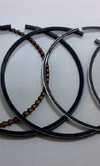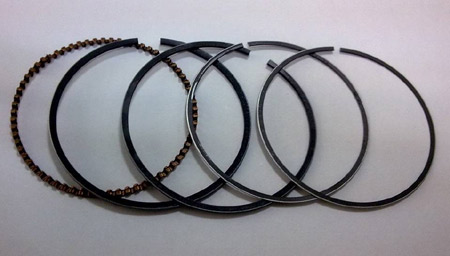Phosphating
 The use of phosphate conversion surface treatments, usually referred to as 'phosphating', are common in industrial applications, often serving as an underlayer for further coating processes such as painting. However, they have a number of applications in race engines and transmissions where they are not combined with further coating processes. In these applications they are applied in order to improve lubrication or for corrosion resistance. In terms of lubrication, phosphate conversion coatings based on zinc and manganese phosphates are generally seen as an aid to 'running in' or break-in.
The use of phosphate conversion surface treatments, usually referred to as 'phosphating', are common in industrial applications, often serving as an underlayer for further coating processes such as painting. However, they have a number of applications in race engines and transmissions where they are not combined with further coating processes. In these applications they are applied in order to improve lubrication or for corrosion resistance. In terms of lubrication, phosphate conversion coatings based on zinc and manganese phosphates are generally seen as an aid to 'running in' or break-in.
The process itself is generally carried out either by immersion or spraying, with the parts being treated using a combination of phosphoric acid and various phosphate salts. There are variations on the coatings, with iron phosphate, zinc phosphate and manganese phosphate being used.
The zinc and manganese variants are most commonly used where improved lubricity is sought. There is the possibility, however, of hydrogen embrittlement through the use of phosphate conversion coatings: the metal-acid reaction liberates hydrogen at the surface, which can be absorbed by the surface, causing it to become brittle and lowering the fatigue limit. The problem is more serious in electroplating processes, and should be borne in mind if specifying phosphate coatings on high-strength steels, which are known to be most affected by hydrogen embrittlement. This hydrogen embrittlement can be minimised by adding an oxidising inhibitor to the solution, which converts any hydrogen to water.
While often specified for corrosion resistance, the phosphate conversion of the surface itself offers only a small improvement, as the phosphate layer is porous. The coating is therefore sealed using oil, which fills in the pores. Both manganese and zinc phosphate treatments are used where corrosion resistance is required.
The more useful property of phosphate treatments to engineers involved in race powertrains is the tendency to improve lubricity and prevent galling during periods of oil starvation, especially at first build and start-up. Again, some of this lubricity comes from the fact that the phosphate coating is sealed with a lubricant, which can be oils or greases.

Where this property of lubricity is required, manganese phosphate coatings are generally specified. The treatment is used on cam followers as an aid to break-in, and is also used on pistons for the same reason. Other notable engine applications are camshafts and piston rings, although gears and cylinder liners have also been treated with success. Owing to the fact that the coatings are porous and hold oil, even as they wear, they present a lubricating surface because there is oil present throughout the structure.
Both manganese phosphate and zinc phosphate treatments can show a range of colours, between black and grey, with the manganese salts showing a generally darker colour.
As mentioned above, one point to be wary of with the phosphating of high-strength steels is the possibility of hydrogen embrittlement. Normally associated with metallic plating processes (most especially with electroplating), this problem occurs where hydrogen is formed at the surface of a steel part. In the case of phosphating, this can happen during 'pre-cleaning' processes, where any oxide layer is removed by acid before phosphating, and during the phosphate process itself. Both involve the interaction of acids and metals; from school we might remember that salts and hydrogen gas are formed. For high-strength steel components, some standards recommend a 'baking' treatment as used with electroplated parts.
Fig. 1 - Phosphating is widely used to treat engine components, including piston rings
Written by Wayne Ward